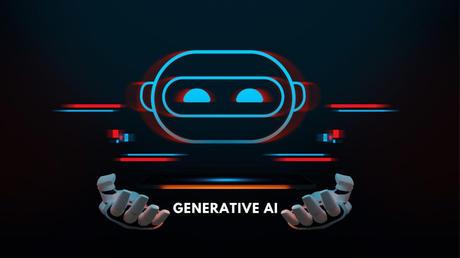Generative AI is probably the most talked about and popular technology in the market. It has made its way into almost all industries, especially IT, and it’s also causing disruption. A recent Salesforce report suggests that 67% of IT businesses are planning to prioritize the use of these AI generator tools within the next 18 months.
The same report also states that 57% of industry leaders believe that generative AI is a game-changing technology. That it has the potential to transform their business. They say that it can help them make their business operation more efficient and offer better client/customer experience.
While there are many benefits of using generative AI technology, it comes with some risks and challenges. In this article, I’ll discuss them in detail and explore effective strategies to minimize them as I’ve used a few of the tools myself.
What Is It?
In simple words, Generative AI refers to the use of AI (Artificial Intelligence) algorithms that can generate/create different types of output on demand. These algorithms are trained on very large datasets to generate outputs like text, images, audio, and video.
Some of the most popular Generative AI tools available in the market include ChatGPT, Midjourney, Dall-E, AlphaCode, and Jasper Chat. To better understand the concept of Generative AI, let’s discuss a simple example.

Generative AI Example
Imagine you have a dataset containing hundreds and thousands of images of cats. You plan to use it to train a generative AI model so that it can learn to identify different features of a cat, such as shape, fur, and eyes.
Once the model is fully trained, you can ask it to make cat images by giving simple instructions. For example, “Create a photo of a cat with a long tail”. The model will use everything it has learned to generate a new cat image that matches your instructions.
Risks and Challenges of Generative AI
According to Avivah Litan, who is a Distinguished VP Analyst at Gartner, the biggest challenges and risks associated with generative AI include copyright issues, cybersecurity risks, data privacy problems, hallucinations, and deepfakes.
There are also some other challenges that you might need to face while using this technology. Let’s discuss all of them in detail.
Copyright Issues
Copyright concerns arise in generative AI due to the extensive training on large internet data that are used to produce new content. The challenge lies in the fact that original content/work that has not been explicitly shared by the creators can be utilized in generating outputs.
This issue becomes especially complex when it comes to AI-generated art, like photos, music, poems, and stories.
For instance, when AI tools like Midjourney and DALL-E make images based on prompts, they reference their training database. The data they use to create results might contain photos created by different artists without proper attribution.
The lack of explicit disclosure regarding the specific works used for training makes it difficult to address these copyright challenges.
Cybersecurity
According to the same Salesforce report (discussed in the introduction part), cybersecurity is the biggest concern of using generative AI for businesses. That’s because 71% of IT leaders believe that this technology introduces new security risks to sensitive business data.
Generative AI undoubtedly has advanced capabilities for content creation, image generation, and coding, but it can also fall into the hands of bad online actors. They can use it to create sophisticated phishing and social engineering attacks.
These can cause reputational and financial damage to your business.
Data Privacy
As mentioned already, organizations use all types of information, including user data, to train their generative AI models, which raises data privacy concerns. This is the reason why Italy banned ChatGPT and claimed that OpenAI lacked legal authorization to collect user data.
Another data privacy risk associated with generative AI is the potential exposure of sensitive and proprietary enterprise information.
When employees interact with generative AI chatbot solutions, there is a possibility of unintentionally sharing confidential data. After that, it won’t be possible to erase that from the memory of generative AI models, and they can retain that for an indefinite amount of time.
Additionally, the vendors of generative AI tools can also use that data to train other AI models. Hence, will compromise confidentiality even further.

Hallucinations
In the context of generative AI, Hallucinations refer to the mistakes or errors that AI models can make due to their reliance on training data. Despite their advanced capabilities, AI models aren’t human and can misinterpret prompts or provide factually incorrect or biased answers.
This becomes a significant concern, especially when you rely on these AI bots for accurate information. Identifying these biased or incorrect responses can be very challenging. Particularly as AI solutions have become more sophisticated and convincing in their interactions.
Ethical Issues with AI Usage
Generative AI can be misused to spread false information and fabricated news, which leads to ethical concerns. One such practice is called deepfakes, which involves the creation of fake videos, images, and voice recordings with malicious intent.
Cybercriminals can use this technology to target enterprises, politicians, and celebrities to damage their reputations or commit fraudulent activities on their behalf.
One of the most popular examples of deepfakes is the viral AI-generated image of Pope Francis wearing a fashionable white puffer jacket. Although it didn’t harm anyone, it serves as a reminder that bad actors can misuse this ai generator tool.
These manipulative creations pose fraud, counterfeit reputational, and political risks to individuals, organizations, and governments.
Poor-Quality Outcomes
Generative AI systems sometimes produce low-quality outputs that contain errors and imperfections. It happens due to multiple reasons, such as not having enough data, insufficient training, or using complex models.
When there isn’t enough data available for the AI system to learn from, it’ll struggle to generate accurate content. Similarly, if the system hasn’t been properly trained or fine-tuned, it’ll produce low-quality and unreliable results.
The complexity of the AI model itself can also contribute to poor-quality outcomes. Complex models require significant computational resources and intricate optimization techniques, making it harder to achieve consistent, high-quality outputs.
Generative AI in Enterprises: Reducing Potential Risks
Click To Tweet
Less Control Over Outputs
When using generative AI systems, you often have less control over the exact nature of the outputs you want. While these systems are trained on a dataset, the generated outputs don’t always match the input data.
For example, in image generation, it may be challenging to precisely control the style, composition, or specific details of the generated images. Similarly, in text generation, the generated text might deviate from the desired tone, style, or accuracy.
This lack of control over outputs can be a limitation in situations where strict adherence to specific criteria or guidelines is necessary. It’ll require additional manual intervention or post-processing to achieve the desired level of control or customization.
That process can be very time-consuming.
How to Reduce Potential Risks Associated with Using AI
Now that you understand what generative AI is, how it works, and what its limitations are, let’s discuss how you can reduce the risks and challenges associated with it.
Preserve Trust
Trust is like currency in business, and losing it can damage your enterprise and lead to revenue and talent loss. According to the Salesforce report, 45% of IT business leaders believe that generative AI can negatively affect the organization’s trust.
If you’re planning to use generative AI technology in your business, you’ll need to take some proactive measures. You’ll need to maintain positive relationships with your customers, employees, and stakeholders.
Here are some effective tips that can help you with that.
- Use advanced risk management tools and strategies to ensure the responsible use of generative AI.
- Foster transparency by clearly explaining how your enterprise will use generative AI, including its capabilities and limitations.
- Address biases actively to ensure fairness and minimize the risk of unwanted/incorrect outcomes.
- Establish strong data privacy measures to protect the sensitive information that your enterprise handles.
- Protect the technology housed on your enterprise’s property with business video surveillance to monitor who is accessing the building.
- Stay updated with laws and regulations governing generative AI and ensure compliance to mitigate legal risks.
Tackle Security and Privacy Risks
With the rapid advancement of generative AI, cyber threats have become increasingly sophisticated and pose a growing risk to organizations.
In order to address these evolving threats effectively, enterprises must implement robust security measures. And then stay proactive in their cybersecurity efforts.
The following is a list of some key security measures to tackle these risks.
- Adopt a Zero-Trust Policy: Implementing a zero-trust approach means continuously verifying and authenticating access to resources, regardless of location or network. It’ll help you make sure that only authorized users have access to sensitive information and reduce the risk of unauthorized access.
- Implement Checks and Balances with Human Oversight: Incorporate human oversight into processes to detect and eliminate fraudulent content. You shouldn’t rely solely on automated processes as it can make your enterprise vulnerable to cyberattacks. Human involvement adds an extra layer of security, enhancing the ability to identify and mitigate potential threats.
- Enhance Data Loss Protection Controls at Endpoints: Another important security practice is to prioritize the strengthening of data loss protection controls at endpoints, such as employee devices. This involves implementing security measures like firewalls. It’ll allow you to monitor and filter network traffic to prevent unauthorized access and protect sensitive information.
- Enhance Data Loss Protection Controls at the Perimeter: You should also use at least a free VPN (Virtual Private Network) services to improve data loss protection controls at the perimeter of the network. These tools will provide secure remote access to company resources and ensure the secure transmission of data, protecting against unauthorized interception.
Improve Content Quality
Ensuring content quality and minimizing bias are critical considerations when implementing generative AI in your business. As discussed already, the output that AI models offer can be biased or incorrect. Therefore, you shouldn’t rely on these tools completely. Yep, I’ve seen that in action!
Imagine a global retail company team using generative AI to personalize promotional offers. They’ll need to make sure that they avoid biased outcomes like offering discounts only to a certain demographic group.
Keep in mind that minimizing incorrect and biased results generated using AI can be a hectic and time-consuming process.
However, you can eliminate this problem using a third-party tool that can identify and remove mistakes and biases from your content. It’ll also help you transform your content (both new and existing) so that it doesn’t fall victim to copyright issues.
But I would look at them yourself or have someone you trust look at it to be 100% sure of the content before it goes out.
Therefore, you shouldn’t rely on these AI tools completely for content.
Click To Tweet
Comply with Regulations
Complying with regulatory bodies is important. That is because it requires you to have a well-defined governance framework that prioritizes responsible and ethical AI deployment.
While the rules and regulations for the responsible use of generative AI are still being made, there are some regulations that you can turn to.
For example, you can refer to resources like the OECD (Organisation for Economic Cooperation and Development) or the Ethics Guidelines for Trustworthy Artificial Intelligence. It’ll allow you to define principles and policies in your enterprise for responsible AI use.
To make this process easy, you can create cross-functional AI ethics committees in your enterprise to shape and enforce ethical guidelines and policies. It’ll help you make sure that your AI deployment aligns with ethical considerations and regulatory requirements.
Creating and Implementing a Generative AI Policy for Enterprises
To effectively manage the risks associated with generative AI, it is crucial to follow a well-defined generative AI strategy. It should be tailored to your enterprise’s specific needs.
Identify Use Cases of Generative AI
Begin by identifying the specific ways in which generative AI will be used within your enterprise. It’ll help you determine different levels of risk associated with each use case.
For instance, using generative AI tools to write blog posts will probably have a lower risk compared to writing technical documentation or code for product development.
Review and Understand Terms of Use
Generative AI systems operate based on prompts and training data, and each system has its own set of rules outlined in terms of use. It’s important to review and understand these terms thoroughly to protect the rights and data of your enterprise.
Develop and Deploy a Policy on Generative AI
Collaborate with security, development, and legal teams to draft company-wide policies that specifically address the identified use cases. Similar to rules governing the use of open-source software, these policies should be detailed and outline approval steps from relevant departments.
It’ll help you minimize the risks associated with AI generator usage and ensure adherence to legal and security requirements.
Compile a Software Bill of Materials
Keep an organized inventory of all software products developed using generative AI. This inventory, known as a software bill of materials, is particularly important for future transactions and due diligence.
It allows for easy tracking of the software products built using generative AI. That can come in handy while making partnerships.
Update the Generative AI Policy Regularly
Generative AI systems, their terms of use, use cases, and the legal landscape are subject to change. That’s why you need to regularly update the policies to reflect these changes and maintain their accuracy and relevance.
Final Words: Helpful AI Generation Technology
There’s no doubt that generative AI is a powerful technology that can help your enterprise in multiple ways. However, you must recognize that along with its advantages, AI generator tools also presents some critical risks and challenges.
You need to take proactive measures to minimize these challenges while implementing generative AI in your organization.
I hope this guide has helped you understand how you can achieve that to make the most out of your generative AI implementation.
What AI generator tools have you been using for your business? I’d love to hear about them in the comments below.

